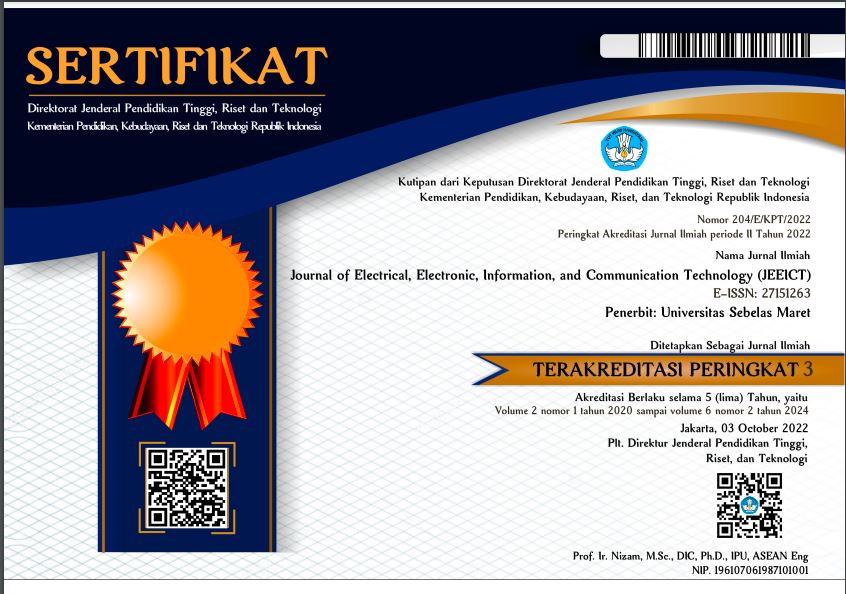IoT with Firebase: Smart Ring Android App Using MAX30100 for Fatigue Detection
Abstract
IoT in healthcare enables real-time health monitoring & data evaluation of patient conditions. One of the benefits of IoT wearable devices is protecting a person from getting exhausted. Body fatigue is an indicator of the emergence of several problems such as sudden attacks of dangerous diseases, accidents, and so on. The large number of deaths from various diseases and accidents that are triggered by body fatigue makes monitoring the level of body fatigue important to minimize this. Through this research, we proposed the Smart Ring; a tool for monitoring and evaluating the level of body fatigue using a wearable sensor and based on the Internet of Things (IoT). In this article, we focus on developing the software component (Android application) and database management system of the Smart Ring IoT system. Age, heart rate, SpO2, and body temperature are used as indicators to determine user’s body condition categories. These data are collected through sensors on hardware part of Smart Ring System. The proposed database management system is able to store collected data inside NoSQL database in the form of documents. Smart Ring Android-based application is capable to monitor three user’s body condition and evaluate them to predict the user’s condition with classification accuracy of 100% within the defined categorization rules. It offers real-time user monitoring for exhaustion signs and triggering timely alerts with sub-2-second data processing under ideal conditions. The proposed Smart Ring system is expected to become an easy to develop, economical and portable medical device which help improve the welfare of society 5.0 in the health sector.
Full Text:
PDFReferences
A. Deguchi et al., “What Is Society 5.0?,” in Society 5.0., Springer Singapore, 2022, pp. 1–23. doi: 10.1007/978-981-15-2989-4_1.
G. Alazie and T. Ebabye, “Impact of Internet of Thing in Developing Country: Systematic Review,” Internet of Things and Cloud Computing, vol. 7, pp. 65–72, Jan. 2019, doi: 10.11648/j.iotcc.20190703.12.
W. Nowakowski, “The Internet of Things – from smart packaging to a world of smart objects?,” ELEKTRONIKA - KONSTRUKCJE, TECHNOLOGIE, ZASTOSOWANIA, vol. 1, pp. 72–77, Oct. 2016, doi: 10.15199/13.2016.10.18.
T. Alam, “A Reliable Communication Framework and Its Use in Internet of Things (IoT),” vol. 3, May 2018.
D. J. J. Amalraj, S. Banumathi, and J. J. John, “IOT Sensors And Applications: A Survey,” vol. 8, no. 08, p. 6, 2019.
A. Das, V. Dhuri, A. Desai, S. Ail, and A. Kadam, Smart Car Features using Embedded Systems and IoT. 2021.
C. Pardhasaradhi and D. Alli, “Industrial Process Automation and Monitoring Using IOT,” Feb. 2021.
S. K. Bairam and S. Chunchu, IOT IN AGRICULTURE. 2022. doi: 10.13140/RG.2.2.15314.89285.
E. Sayed Ali Ahmed and Z. Kamal, “Internet of Things Applications, Challenges and Related Future Technologies,” world scientific news, Jan. 2017.
A. Albesher, “IoT in Health-care: Recent Advances in the Development of Smart Cyber-Physical Ubiquitous Environments,” Feb. 2019.
S. Badugu, K. Srikanth, and L. N. Inampudi, “IoT for Healthcare,” International Journal of Science and Research (IJSR), vol. 5, pp. 2319–7064, Feb. 2016.
H. T. Yew, M. Ng, S. Ping, S. Chung, A. Chekima, and J. Dargham, “IoT Based Real-Time Remote Patient Monitoring System,” Feb. 2020, pp. 176–179. doi: 10.1109/CSPA48992.2020.9068699.
R. Ramly, A. Abu Bakar Sajak, and M. Syahmi, IOT-BASED GLUCOSE MONITORING SYSTEM. 2020. doi: 10.13140/RG.2.2.33859.63522.
S. Khamitkar, “IoT based System for Heart Rate Monitoring,” International Journal of Engineering Research and, vol. V9, Aug. 2020, doi: 10.17577/IJERTV9IS070673.
N. Karimpour, B. Karaduman, A. Ural, M. Challenger, and O. Dagdeviren, “IoT based Hand Hygiene Compliance Monitoring,” Jun. 2019, pp. 1–6. doi: 10.1109/ISNCC.2019.8909151.
I. De la Torre Díez, S. Góngora Alonso, S. Hamrioui, E. Cruz, L. Morón, and M. Franco, “IoT-Based Services and Applications for Mental Health in the Literature,” Journal of Medical Systems, vol. 43, Dec. 2018, doi: 10.1007/s10916-018-1130-3.
C. Asiminidis, G. Kokkonis, and S. Kontogiannis, “Database Systems Performance Evaluation for IoT Applications,” SSRN Electronic Journal, vol. 10, Jan. 2018, doi: 10.2139/ssrn.3360886.
R. Agrawal and C. Nyamful, “Challenges of big data storage and management,” Global Journal of Information Technology, vol. 6, Mar. 2016, doi: 10.18844/gjit.v6i1.383.
C. Khawas and P. Shah, “Application of Firebase in Android App Development-A Study,” International Journal of Computer Applications, vol. 179, pp. 49–53, Jun. 2018, doi: 10.5120/ijca2018917200.
“MAX30100 Sensor Datasheet pdf - Heart-Rate Sensor. Equivalent, Catalog.” https://datasheetspdf.com/pdf/950845/MaximIntegrated/MAX30100/1 (accessed Aug. 23, 2022).
D. Jing, S. Zhang, and Z. Guo, “Fatigue driving detection method for low-voltage and hypoxia plateau area: A physiological characteristic analysis approach,” International Journal of Transportation Science and Technology, vol. 9, no. 2, pp. 148–158, Jun. 2020, doi: 10.1016/j.ijtst.2020.01.002.
F. Kobayashi et al., “Blood Pressure and Heart Rate Variability in Taxi Drivers on Long Duty Schedules,” Journal of Occupational Health, vol. 44, no. 4, pp. 214–220, 2002, doi: 10.1539/joh.44.214.
L. R. Hartley, P. K. Arnold, G. Smythe, and J. Hansen, “Indicators of fatigue in truck drivers,” Applied Ergonomics, vol. 25, no. 3, pp. 143–156, Jun. 1994, doi: 10.1016/0003-6870(94)90012-4.
A. Aryal, A. Ghahramani, and B. Becerik-Gerber, “Monitoring fatigue in construction workers using physiological measurements,” Automation in Construction, vol. 82, pp. 154–165, Oct. 2017, doi: 10.1016/j.autcon.2017.03.003.
J. González-Alonso, C. Teller, S. L. Andersen, F. B. Jensen, T. Hyldig, and B. Nielsen, “Influence of body temperature on the development of fatigue during prolonged exercise in the heat,” J Appl Physiol (1985), vol. 86, no. 3, pp. 1032–1039, Mar. 1999, doi: 10.1152/jappl.1999.86.3.1032.
L. Aljihmani et al., “Classification of Fatigue Phases in Healthy and Diabetic Adults Using Wearable Sensor,” Sensors, vol. 20, no. 23, Art. no. 23, Jan. 2020, doi: 10.3390/s20236897.
A. Sapra, A. Malik, and P. Bhandari, “Vital Sign Assessment,” in StatPearls, Treasure Island (FL): StatPearls Publishing, 2022. Accessed: Aug. 23, 2022. [Online]. Available: http://www.ncbi.nlm.nih.gov/books/NBK553213/.
“Hypoxia vs Hypoxemia (Low Blood Oxygen): Causes, Symptoms, Treatment & Chart,” MedicineNet. https://www.medicinenet.com/hypoxia_and_hypoxemia/article.htm (accessed Aug. 23, 2022).
Refbacks
- There are currently no refbacks.







